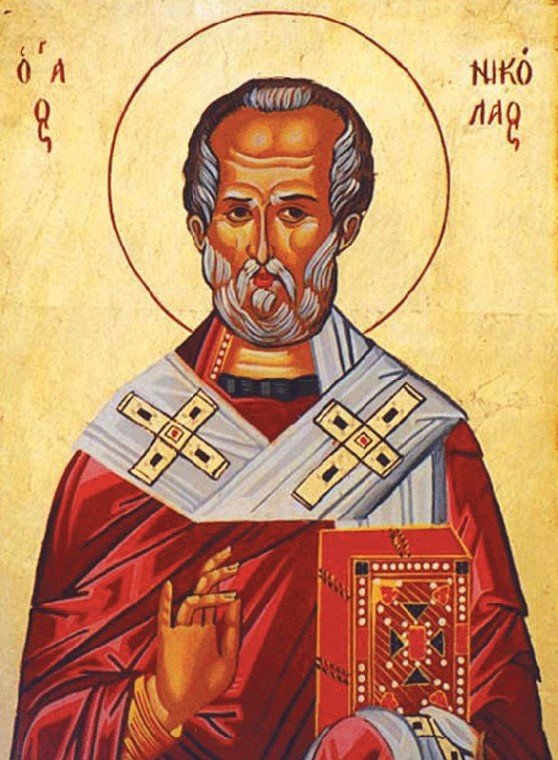As little ones anxiously await the arrival of Santa tonight,
there will be trays of milk and cookies, favorite snacks and
carrots for Rudolph placed on mantles from coast to coast.
Not everyone is waiting for jolly old St. Nick tonight, though.
Santa Claus, whose known aliases include Saint Nick and Father
Christmas, is still the most popular gift giver worldwide, but he
doesn’t wear a red and white suit everywhere he goes, and he’s not
even present in quite a few countries.
As little ones anxiously await the arrival of Santa tonight, there will be trays of milk and cookies, favorite snacks and carrots for Rudolph placed on mantles from coast to coast.
Not everyone is waiting for jolly old St. Nick tonight, though. Santa Claus, whose known aliases include Saint Nick and Father Christmas, is still the most popular gift giver worldwide, but he doesn’t wear a red and white suit everywhere he goes, and he’s not even present in quite a few countries.
In Brazil he’s known as Papai Noel (Father Noel) and is said to live in Greenland. His summer trip ( yes, it’s summer in the southern hemisphere) to Brazil results in such a climate change that he’s forced to wear silk clothing that will breathe in the heat.
For Greeks, St. Nicholas is the patron saint of sailors. Thus, he’s said to appear drenched in brine with a beard dripping sea water and a face covered with sweat from working so diligently to reach sinking ships.
Children in the Czech Republic and Slovakia know this character as Svaty Mikalas, a saint who climbs down from heaven on a golden rope with an angel and a whip-toting devil to aid him in his night’s work.
In other countries, local folklore dictates different gift-givers. The baby Jesus is said to deliver gifts in many Eastern European countries, where children leave their shoes out by the fireplace, whereas Japanese children are visited by Hoteiosho, a Japanese god said to have eyes in the back of his head (perfect for seeing who’s naughty or nice).
In Italy, Strega Buffana (also called Strega Nonna) is a witch who delivers presents while riding around on a broom, while Australian children look for Santa’s sleigh flying across the sky … pulled by 8 white kangaroos.
Kids in Russia receive their gifts from Babushka, who is said to have refused to give the three wise men food and shelter. She now searches for the Christ Child while visiting homes during the winter season.
Here are a few other Christmas traditions from around the world:
• TRINIDAD & TOBAGO Soca parang is the sound of the season as groups carrying guitars, steel drums, tambourines and other portable instruments serenade their neighbors, sometimes late into the night. The group doesn’t stop until they’re invited into the house for refreshments.
• CONGO Parishioners carol on their way to evening services, bringing with them gifts that will be presented at the altar in honor of Jesus’ birthday.
• SWEDEN Feasts and celebrations of Christmas begin Dec. 13 with the appearance of St. Lucia. In the home, this figure is represented by a girl, generally the eldest daughter, dressed in white and wearing a crown of candles, who will wake her parents with coffee and cookies. To choose the Lucia who will preside over the national parade in Stockholm, there is an official popular election.
• INDIA Christians decorate banana or mango trees and fill their churches with poinsettia blooms (naturally in flower there at this time of year) for Midnight Mass. In southern India, small clay lamps illuminate the rooftops and walls of Christian homes, an adaptation of the Hindu community’s Diwali (festival of light), which is held in October or November.
• NEW ZEALAND Many people choose to celebrate Christmas twice a year here, reveling in the holiday’s winter aspects in mid-July. During the summer celebration in December they’re most likely to feast on foods roasted in a Maori Hangi, a pit filled with hot rocks and food covered by sand and allowed to roast for hours.
• DENMARK Families leave a bowl of rice pudding out for the Julnisse – a mischievous house elf. If he likes the pudding, Julnisse will watch over the home for the next year. Otherwise, he’ll play jokes on the family.
• AUSTRIA Children are reminded to be good during the Christmas season by the appearance of Krampus, an evil spirit with a long tongue and bulging eyes who rattles cow bells and chains on Dec. 5. Children and adults pelt the creature with snowballs as he runs through the streets of the city. On Christmas itself, they’ll be visited by Christkindl, who brings presents and decorates the tree with the assistance of angels, or mom and dad.
• VENEZUELA Misa de Aguinaldo, or early morning Mass, is a daily exercise from Dec. 16 to 24. In the city of Caracas, it is tradition to roller skate to this event, and many streets are closed to cars until 8am for just that purpose.
• PHILIPPINES Firecrackers are set off during this summer celebration and children go caroling in exchange for candy, much like our Halloween “trick or treat” activities.
• WALES Eisteddfodde, or caroling, is the most popular activity of the season, where many groups are accompanied by harps. An official set of lyrics is distributed each year so that towns may compete to produce the best accompanying score. A winner is chosen by national contest.
Sources:
www.Christmas.com,
www.NorthPole.net,
www.The-North-Pole.com,
www.Santas.net
www.RuchisKitchen.com
THE REAL ST. NICK
The real St. Nicholas was born around 280 A.D. and eventually rose to become the bishop of Myra, Turkey (the town is now called Demre and sits on the country’s southern shores, a three-hour bus ride from St. Nicholas’ purported birthplace in Patara, Turkey).
Best known as one of the creators of the Nicene Creed, a statement of religious belief repeated by Orthodox Christians worldwide in services today, the only reputable historical documentation of St. Nicholas’ existence are meeting records from the First Council of Nicaea in 325. He argued that Jesus of Nazareth should be counted as a member of the Holy Trinity.
Following his imprisonment for spreading Christianity from 310 to 313, when Roman Emperor Constantine converted to Christianity and made it the official religion of the empire. Nicholas lived with the approval of Rome until his death in 343 A.D. In death, his fame spread rapidly as his bones were purported to heal the sick. The patron saint of children, poor virgins, sailors, innocent prisoners and all Russians, his bones were fought over between the Byzantines, Italians and others.
More than 1,600 years later, the sparse remains of the saint – a finger bone, some skull fragments and a few other pieces – are spread around the globe. In Turkey, the town of Demre holds a three day festival to commemorate Nicholas’ official Dec. 6 feast day, but since the country is largely Muslim, Christmas is not a widely celebrated event.
Sources: World Book Encyclopedia, www.Christmas.com and Al-Ahram Weekly.













